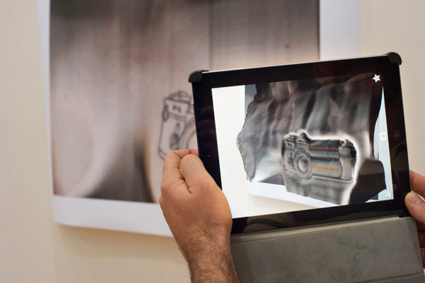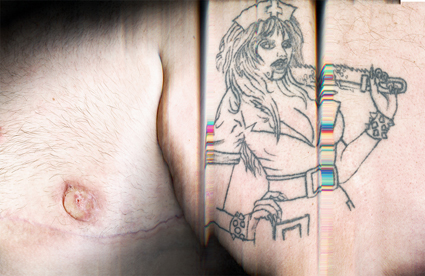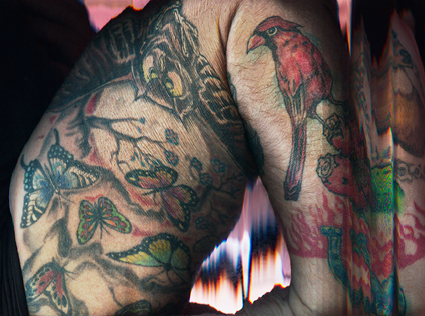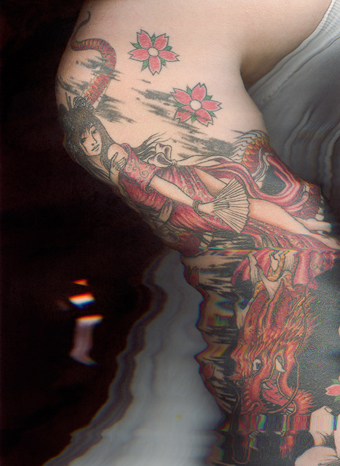 |
Alison Bennett, Shifting Skin courtesy the artist |
Artist statement
Shifting Skin is a series of artworks featuring 3D augmented reality over high quality photographic prints of human skin marked by tattoos. This work was made in the course of my creative practice research as a member of the Deakin Motion.Lab. Development was guided by a consideration of surface in digital photography. My previous work has tested the representation of interior space in digital images. Having reached something of a conclusion in this line of investigation in Cavity—a series of stitched panoramas of the interiors of caves with an overlay of inhabitation—I realised that space and surface were co-creative: space is defined by surface.
Prompted by an invitation to make work on the subject of queer beards, I was experimenting with the possibilities of scanography to reveal forensic details in skin—pores and hairs, scars and tattoos. While meditating on surface as a creative constraint, I realised that skin is a primary surface, the site of subjectivity, the border at which we perceive and are perceived.
 |
Alison Bennett, Shifting Skin, Untitled (zombie), 2013 courtesy the artist |
I am a digital native. My father was a computer scientist in the 60s and I grew up with a computer in the house in the days before there was a tangible difference between a PC and a Mac. Digital images make sense to me and I am endlessly fascinated by the cultural and psycho-social implications of digital technologies. There has been a profound shift in our engagement with what has been termed 'cyberspace' from an alternative virtual reality to an overlay embedded in the everyday and the physical. Augmented reality is not only emerging as a media technology but as a potential conceptual model to describe the contemporary dynamic between the so-called physical and digital. The digital is overlaid and embedded, not a virtual alternative.
www.alisonbennett.com.au
Tattoo dreaming
There’s a lot of ink around today. Sometimes I imagine a future in which so many generations have been tattooed that there’s a Darwinian glitch and babies come out of the womb pre-decorated. This of course would be a disaster as it undermines the very spirit of getting a tattoo—the agency involved in choosing your own new skin.
Alison Bennett’s Shifting Skin depicts a number of lovingly chosen body decorations but rather than photographing them she has scanned them, using a modified flatbed scanner. Studying someone else’s tattoo can be intimate at the best of times and Bennett’s scanning method, along with the scale of her images, makes it even more so, highlighting the skin’s scars, flaws, puckers and gaping hair follicles.
 |
Alison Bennett, Shifting Skin, Untitled (birds & butterflies), 2013 courtesy the artist |
Pointing the device’s camera at one of the images, the flatness begins to buckle and fold developing hills and valleys, sharp cliff edges and chasms—a contour map of the skin. Bennett avoids any literalising of the images. Rather than simply transforming the flat illustration into a three dimensional version of itself, she disrupts the tattooed image with extraneous lumps and bulges that don’t so much complement the image as mutate it into something else altogether.
 |
Alison Bennett, Shifting Skin, Untitled (dragon), 2013 courtesy the artist |
As she mentions in her artist statement above, Alison Bennett sees the skin as a border. In Shifting Skin this works not only as a border between what is in and outside the body, but here it also operates on a metaphoric level with skin becoming the semi-permeable membrane between reality and fantasy. The material world crosses over to meet the fantastical, or perhaps the fantastical reaches out and grabs the real. For the viewer it’s this moment of border crossing that is most exhilarating, but as the technology becomes increasingly utilised for commercial means (there are already multiple examples of corporate clients on the Aurasma website), the initial thrill may begin to normalise. Then it will be the content that becomes most important and artists like Bennett will hopefully lead the way, bending reality in ever more conceptually challenging ways. Gail Priest
Shifting Skin, Alison Bennett, 10x8 Gallery, Central Park, Chippendale, presented as part of the Sydney Gay & Lesbian Mardi Gras Festival; http://10x8gallery.com/; www.alisonbennett.com.au
© Gail Priest; for permission to reproduce apply to [email protected]








 back
back